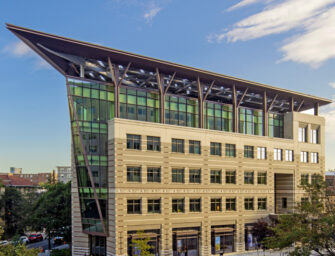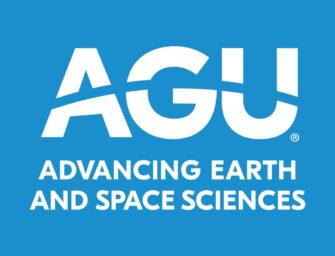Fall Meeting 2015: The Start of Something Terrific
By Denis-Didier Rousseau (Centre National de la Recherche Nationale), Fall Meeting Program Committee Chair
As the last sessions of the 2015 Fall Meeting came to a close, I paused to think about how ‘the stars had aligned’ to make this well-respected event even more special.
The week began with news from Paris that a climate agreement had been reached. What better way could there be to start the largest gathering of Earth and space scientists in the world? To see such commitment to addressing the growing and harmful impacts of climate change from nearly 200 countries was inspiring. And I’m sure others felt, as I did, as a sense of hope that the research being presented in San Francisco this week would be part of the solution.
We had several important events that helped to highlight for me how well-respected and important AGU’s Fall Meeting:
First, the organizers at XPRIZE, the world leader in designing and launching large incentive prizes to drive radical breakthroughs for the benefit of humanity, chose the Fall Meeting as the place to announce their newest challenge. On Monday, they joined us to launch the Shell Ocean Discovery XPRIZE, a three-year, $7 million global competition challenging teams to advance ocean technologies for rapid and unmanned ocean exploration.
Second, on Tuesday, Elon Musk, the CEO and Lead Designer at Space Exploration Technologies and the CEO and Product Architect at Tesla Motors, Inc., served as the 2015 Presidential Forum speaker. To have someone of his talent and prominence join us for a ‘fireside chat’ on topics ranging from education and space exploration, to climate change and investing in science, was very special. There is much to be learned from his experiences and his approaches to innovation, and I was honored to have him join us.
And finally, France Cordova, the leader of the National Science Foundation, joined us for the Union Agency Lecture. Having the leader of such a prestigious agency come to the Fall Meeting to talk with AGU’s attendees was an important and exciting opportunity. Having her come so early in her tenure as director—which indicates the level of importance she assigns to AGU and our attendees—was even more impressive.
We also had the privilege help the International Geosphere Biosphere Program (IGBP) celebrate the end of its mission and the transition into a new, exciting organization called Future Earth, which took place during a celebration dinner on the evening before the start of the meeting. For three decades, IGBP was responsible for building understanding and awareness about our planet, including its role in focusing our collective attention on the Anthropocene, within the scientific community AND the public. As Future Earth moves into take on that role, it will focus on linking the natural and social sciences and co-designing programs with stakeholders to ensure the greatest possible results.
There is no other place more appropriate than AGU’s Fall Meeting—the largest gathering of Earth and space scientists in the world—to celebrate IGBP’s achievements. We wanted this celebration to be more meaningful than simply throwing a party, so from the very beginning of our 2015 planning, we worked to integrate IGBP’s programs into the sessions and events of the Fall Meeting. This approach resulted in several terrific events:
An amazing Union session
Several scientific sessions
An engaging Great Debate about the Anthropocene
An informative and enlightening Frontiers of Geophysics lecture from Dr. Gordon McBean of the International Council for Science (ICSU) about the process and reason for the transition from IGBP to Future Earth and what the future holds; and
A very special event . . . Bella Gaia. When IGBP suggested bringing an artistic performance that was rooted in scientific data and imagery to the meeting, we enthusiastically said yes. Thursday evening’s performance, which included music and dance set on a backdrop of images from NASA, and a panel discussion that included leaders from AGU, IGBP, Future Earth and astronaut John Grunsfeld, was entertaining and thought-provoking. And by opening it to the public in addition to Fall Meeting attendees, we hoped to raise awareness and appreciation for the role scientists play in facilitating our successful and effective stewardship of the planet and its resources.
I’m also very proud of a special session we hosted called the New Generation of Scientists, which was designed to highlight the work of AGU’s Macelwane Medal winners. During the honors ceremony two years ago, I recognized that these individuals’ accomplishments were significant enough to merit recognition, but we weren’t giving them time to talk about their science – or giving ourselves time to learn from them. This session is our effort to call further attention to their great work and to have them serve as examples for the next generation of scientists.
While these things perhaps were the most obvious signs of the success of the 2015 meeting, the connections that were made during poster sessions, the students who challenged themselves by participating in our pop-up talks, the attendees who used the SWIRL sessions to learn more about interdisciplinary science, and the researchers who flocked to the Data Fair to learn about the latest developments, were equally important and inspiring. Whether it is a single big moment or 10 small ones, I hope you each found some hope and inspiration during your time with us this past week.
None of this would have been possible without the assistance of the Fall Meeting Program Committee and the AGU staff, and the support of the AGU leadership, to whom I owe a great deal of gratitude.




There are no comments
Add yours